How to Control Periodical Cicada Insect
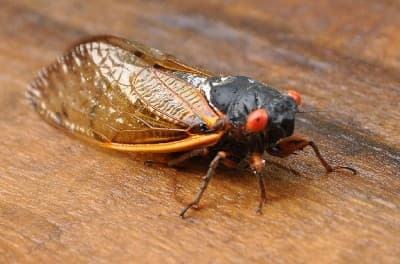
About Cicadas
Cicada bugs are present in many areas of the country. In areas where a limited number of these insects are present, they pose only a minor nuisance. However, in areas where they emerge in major broods all at once by the millions, they can do serious damage to young trees, bushes, and shrubs in your yard. In addition, their high-pitched, shrill noise is very irritating. The Cicada life cycle includes several 13-year and a 17-year broods. While Cicadas are fascinating to some, their presence in big numbers is unnerving to many people. They are sometimes incorrectly referred to as a “Locusts”. This guide will help you to control periodical cicada insects.
Other names: Cicadas are also called 17 year Locust, 13 year Cicada, 17 year cicada, and Periodical Cicada.
Large spring hatches, called “broods”, emerge in 13 year and 17 year cycles. When a Cicada emergence hits an area, the best protection for your trees and shrub is pest netting with a 1/4″ mesh.
Is your area affected this year by either emergence? See the Cicada Brood Map
Cicada Images and Pictures – See what the “buzz” is all about.
An important distinction: Cicadas are present in many areas of the country in small numbers. In the summer, many of us can hear an occasional loud, shrill Cicada somewhere in a tree. However, when a large brood hatches and emerges from the ground, it is an entirely different event. They emerge by the thousands, or even by the millions. During their brief emergence, they are a major nuisance. More on Seasonal Cicada
Cicada Brood Emergence
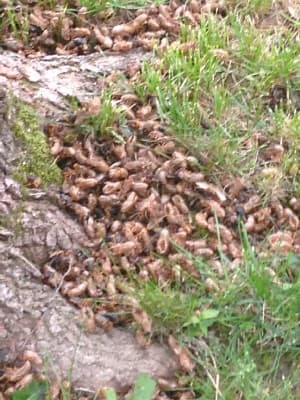
Cicadas are flying, plant-sucking insect that emerges in periodic cycles. Cicada nymphs suck juices from the roots of plants. Females lay eggs causing significant damage to trees, bushes, and shrubs, during their brief adult stage. They are not harmful to humans. Counter to some rumors, they do not bite, nor do they often land on a human or animal.
Most, but not all years, a Cicada brood hatches, affecting anywhere from a small area to several states. When a particular brood matures and emerges, it is usually in many millions of insects. Fortunately, their adult life span above ground is very brief, lasting about four to six weeks.
When a Cicada emergence hits an area, the best protection for your trees and shrub is pest netting with a 1/4″ mesh.
Types of Periodical Cicada by Life Cycle
There are two basic types of Cicadas:
Periodic, 2-8 year cycle– These insects “seem” to appear every year in some areas, because their life cycle is staggered. Actually, a different brood is hatching each year to make it seem like they are annual.
13 to 17 year cycle- This group does not appear every year. When they do emerge, it is in huge numbers. They are sometimes called “17 Year Locusts”. Although, they are not related to locusts.
Cicada Life Cycle
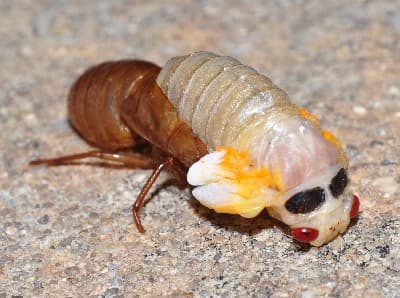
While the Cicada life cycle may be as long as 17 years, they spend almost all of their lives underground. The nymphs emerge from the ground in periodic cycles. These nymphs climb up trees and quickly shed their skins(molt). Adult flying cicadas emerge from the skin. The adult Cicadas’ entire purpose in life is to mate and produce offspring. You can hear the males’ mating “song”, from early morning to nightfall. In heavily infested areas, the noise can be quite disturbing. About five to ten days after mating, the female lands on twigs of deciduous trees cuts slits in them, and lays her eggs in the slit.
Adults do not eat. Damage to trees is caused by the adult female, as she cuts slits into twigs and small diameter branches, to lay her eggs. Shortly after mating, the male dies.
The eggs hatch, producing tiny nymphs that fall to the ground. The nymphs burrow into the soil and feast on underground tree roots. They remain there for years, slowly growing until their periodic cycle calls them to emerge again as adults.
How Cicadas Harm Trees and Shrubs
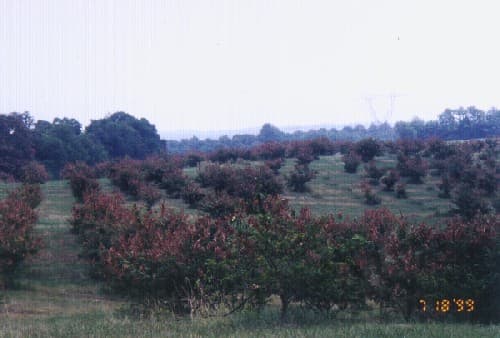
It’s the female that harms trees. Choosing deciduous trees, she cuts two slits in small pencil-sized (or smaller) branches and twigs and lays about 24 eggs. She then goes on to another twig and repeats the process. A female cicada can deposit up to 600 eggs.
Where infestations are heavy, the egg-laying process is repeated on a tremendous number of twigs. This causes the twigs(or ends of the tree) to die, and often break off. A heavy infestation often destroys young trees and bushes. While the damage may look bad on large trees, a mature tree usually survives the damage. Although damaged trees may look unsightly, for a year or two.
Affected Trees, Bushes, and Shrubs
Females seek woody stalks, 1/2 inch or less in diameter. Pines are not bothered, because of the sap. Any trees from soft gum trees to medium beech, apple, etc. to harder woods such as maples, oaks, hickory. The real key is branches that are 1/2″ to 1″ in diameter or less, with long open sections where they can “stitch” (lay) eggs.
Needs Protections
Apple Trees
Arborvitae
Ash
Beech
Black Eyed Susan
Crab Apple
Cherry
Dogwood Tree
Fruit Trees in general
Grape vines
Hawthorn
Hickory
Holly
Japanese Maple
Lilacs
Magnolia
Maple
Oak
Peach Tree
Pear Tree
Raspberry vines
Rhododendron
Roses
Rose of Sharon
Spirea
Viburnum
Willow
Doesn’t Need Protection:
Most Flowers
Herbs
Vegetables
Pine and Firs
Cicadas Versus Locusts
People sometimes think of these insects as the same. As a result, they confuse and interchange the names of these very different insects. Both insects can be seen in huge numbers. However, aside from the fact that they are both insects, they are not related.
Cicadas are related to aphids. These insects produce a high, shrill buzzing noise. 13 year cicada and 17 year cicada broods emerge in the spring in some parts of the country. During a large brood emergence, the sound is very irritating. They do not fly far. Cicadas harm or kill shrubs and small trees as they deposit their eggs in the bark. While they are a nuisance and often land on vegetable crops, they do not eat or harm them.
Locusts are related to grasshoppers and are similar in appearance. They gather in massive numbers and are capable of doing major damage to food crops. Locusts often travel long distances as they devour fields of crops, and then move on to “greener pastures”.
How to Control Cicada and Locust
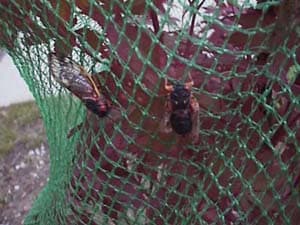
It is not a question of how to control cicadas. Insecticides are ineffective on these large insects. The real question is how to keep them from damaging or killing susceptible trees and shrubs.
Many animals eat them, including birds, dogs, and cats. Humans eat them, too. If you are so inclined, there are recipes online! Cicadas emerge for a very brief period in huge numbers. The feast is short-lived. Natural predators don’t make a big dent in their populations.
Insect Netting is the most effective way to protect young trees and shrubs, which are most susceptible. Because Cicadas are large insects, a 1/4″ mesh netting is effective. Wrap pest netting completely around the tree and tie or seal it off, to keep any insects from finding an entryway.
Important Note: Even if they have emerged in your area, you have 5-10 days to cover young trees before the female begins to cause damage, as she lays her eggs.
More Related Articles
Learn about Cicadas – How to control cicadas and more.
Seasonal Cicadas – emerge in small numbers in many parts of the country. They are mainly a noisy nuisance causing little or no damage.
Brood Emergence by year and affected states.
Pictures and Images – See what the “buzz” is all about.
Damage Pictures – see what it does to trees.
Cicadas – at Garden Hobbies
Please support our site. Shop for:
- rmmatthews100@hotmail.com
- 585-721-6528
- Rochester, NY
©1999-2024 GardenersNet.Com, All Rights Reserved

